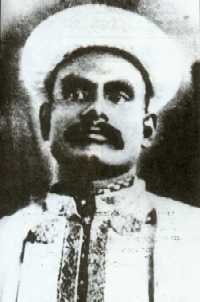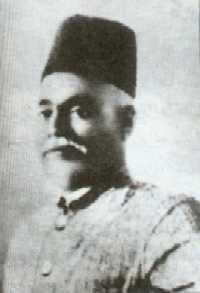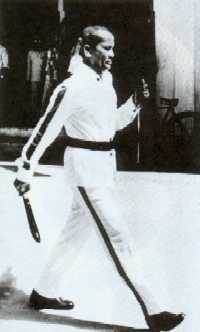|

King Mohammed Shamsuddin III: He was the last king
of Maldives to enjoy any level of executive power. His
33-year reign spanned the transition from absolute monarchy to
constitutional rule.
On 29 March 1904 Dhoshimeyna Kilegefan discussed with
the nobles and informed King Shamsuddin of their
intention to hold his entitlement ceremony . Six days
later he summoned the public to the Gulhakulhey
field and announced this to the public, who gave their
unanimous support, which the Prime Minister conveyed to His
Majesty the King. Kilegefan returned once again to
convey to the public His Majesty's gratitude for their
support. Before dismissing them he also informed them
that the British Government in Colombo approved of the
proposed ceremony.
Now, this last piece of information was interesting.
This incident occurred long before the Maldives had
developed telecom links with the outside world. The only
means of communication with Colombo was the sailing "odi",
which normally took several weeks for the round trip.
So, how did Kilegefan get the approval so fast?
Obviously he had already discussed the issue with the British
long before he discussed it either with His Majesty the King
or the nobles.

Prime Minister Ibrahim Dhoshimeyna Kilegefan: He
stage managed not just this ceremony, but the entire country
and its transition to democracy.
What followed was an intense period of preparation
for the big event. Agents set sail with long lists
of decorative items, some to the atolls, others abroad.
Citizens of Male started repairing old buildings and
whitewashing them. Mausoleums and monuments in Male got a face
lift and had new flags hoisted. Word also spread to
other islands, which also joined the national mood.
Finally, Kilegefan announced 4 August 1904 as
the big day and set 25 July as the deadline for
the final preparations, which included raising large flags in
strategic locations in Male. The town crier's route
got special attention. Teams of workers widened the
roads in the route to 11 cubits (about 25 ft). They
fixed flag posts at 4.5 ft intervals and hoisted
red flags . Between the flag posts stretched sheets of
colorful cloth.
On the eve of the big day, in the late
afternoon of 3rd August, King Shamsuddin visited
the holy places in Male in procession and offered special
prayers before returning to the palace.
Finally the big day arrived. In the morning,
Sir John Kimbernet, representative of the Governor of Ceylon,
disembarked from his warship in ceremony, and sat with the
Maldivian nobles in the special tent prepared in Gulhakulhey
field. At 10 O' clock the King emerged with his nobles.
The ceremony began and proceeded according to long
established traditions. An important part of tradition was
obtaining the consent of the people. For this purpose
the chiefs of selected islands had been summoned to a
special tent at the venue. They were asked whether they
were happy with the decision to make Shamsuddin king.
They replied they were happy on the condition that he
looked after the poor and dispensed justice.
The king then sat on his throne. Above
his head the royal canopy unfurled. The
nobles then paid their homage to the king, first
Kilegefan then others in the order of precedence.
In the background, a bugle call heralded the newly
inaugurated king and canons boomed a 7 gun salute.
Finally it was the turn of the koli kaleyge (town
crier) to announce the happy event to the people. This
was the usual way important announcements were made to the
public, particularly those relating to the conferring of
titles. Over time the word 'koli' it self
had become almost synonymous with titles

Babagey Dhon Manik: One of the last town
criers of Maldives. He was also the author of an
important book on Maldivian culture, which served as a
reference for this article. This photo was taken during
a later koli ceremony in the 1970s.
The koli kaleyge dressed up in his
decorative uniform and went out in procession along the
specified route. He stopped at important locations
to announce the koli. First, he struck a brass gong with his
hammer to get attention, then went on to recite a long
passage in old Dhivehi, which essentially detailed His
Majesty's titles and privileges.
Three days of celebrations followed the big event.
Nobles offered lunches and dinners in the form of
traditional 'keyms' . Gifts exchanged hands in
profusion. The celebrations also spread to all islands in the
country. Little did the regaling crowds realize
that this would be the last such celebration ever in the
Maldives.
|




